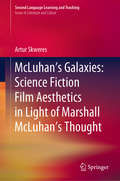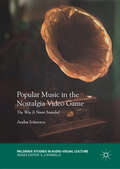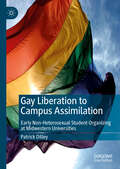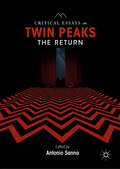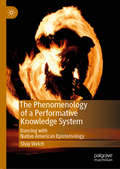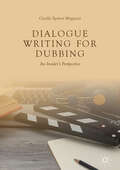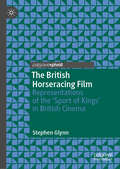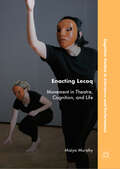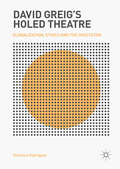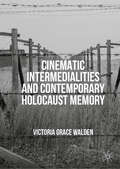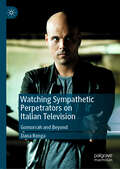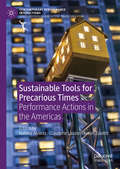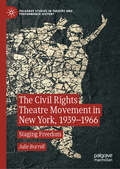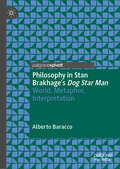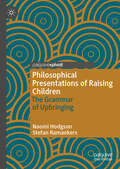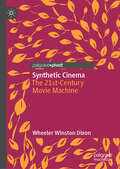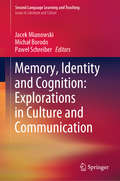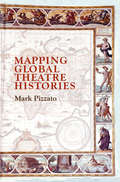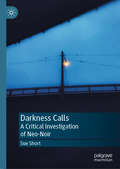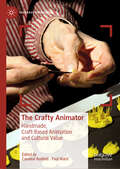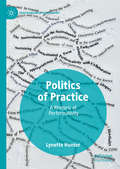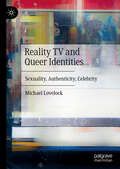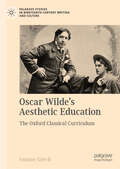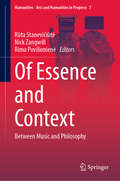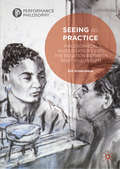- Table View
- List View
McLuhan’s Galaxies: Science Fiction Film Aesthetics in Light of Marshall McLuhan’s Thought (Second Language Learning and Teaching)
by Artur SkweresThis groundbreaking book uses observations made by Marshall McLuhan to analyze the aesthetics of science fiction films, treating them as visual metaphors or probes into the new reality dominated by electronic media: - it considers the relations between the senses and sensuality in Blade Runner, the visually-tactile character of the film, and the status of replicants as humanity’s new clothes; - it analyzes the mixture of Eastern and Western aesthetics in Star Wars, analyzing Darth Vader as a combination of the literate and the tribal mindset; - it discusses the failure of visual society presented in the Terminator and Alien franchises, the rekindling of horror vacui, tribalism, and the desire to obliterate the past as a result of the simultaneity of the acoustic space; - finally, the book discusses the Matrix trilogy and Avatar as being deeply related in terms of the growing importance of tactility, easternization, tribalization, as well as connectivity and the implosion of human civilization.
Popular Music in the Nostalgia Video Game: The Way It Never Sounded (Palgrave Studies in Audio-Visual Culture)
by Andra IvănescuThis book looks at the uses of popular music in the newly-redefined category of the nostalgia game, exploring the relationship between video games, popular music, nostalgia, and socio-cultural contexts. History, gender, race, and media all make significant appearances in this interdisciplinary work, as it explores what some of the most critically acclaimed games of the past two decades (including both AAA titles like Fallout and BioShock, and more cult releases like Gone Home and Evoland) tell us about our relationship to our past and our future. Appropriated music is the common thread throughout these chapters, engaging these broader discourses in heterogeneous ways. This volume offers new perspectives on how the intersection between popular music, nostalgia, and video games, can be examined, revealing much about our relationship to the past and our hopes for the future.
Gay Liberation to Campus Assimilation: Early Non-Heterosexual Student Organizing at Midwestern Universities
by Patrick DilleyThis book outlines the beginning of student organizing around issues of sexual orientation at Midwestern universities from 1969 to the early 1990s. Collegiate organizations were vitally important to establishing a public presence as well as a social consciousness in the last quarter of the twentieth century. During this time, lesbian and gay students struggled for recognition on campuses while forging a community that vacillated between fitting into campus life and deconstructing the sexist and heterosexist constructs upon which campus life rested. The first openly gay and lesbian student body presidents in the United States were elected during this time period, at Midwestern universities; at the same time, pioneering non-heterosexual students faced criticism, condemnation, and violence on campus. Drawing upon interviews, extensive reviews of campus newspapers and yearbooks, and archival research across the Midwest, Patrick Dilley demonstrates how the early gay campus groups created and provided educational and support services on campus–efforts that later became incorporated into campus services across the nation. Further, the book shows the transformation of gay identity into a minority identity on campus, including the effect of alliances with campus racial minorities.
Critical Essays on Twin Peaks: The Return
by Antonio SannaThis edited collection offers an interdisciplinary study of Twin Peaks: The Return, the third season of a TV program that has attracted the attention (and appreciation) of spectators, fans, and critics for over two decades. The book takes readers into several distinct areas and addresses the different approaches and the range of topics invited by the multidimensionality of the subject itself: the philosophical, the artistic, the socio-cultural, and the personal. The eighteen chapters constituting the volume are academic in their approach to the subject and in their methodology, whether they apply a historical, psychoanalytical, film studies, or gender studies perspective to the text under examination. The variety and range of perspectives in these aforementioned chapters reflect the belief that a study of the full complexity of Twin Peaks: The Return, as well as a timely assessment of the critical importance of the program, requires both an interdisciplinary perspective and the fusion of different intellectual approaches across genres. The chapters demonstrate a collective awareness of the TV series as a fundamental milestone in contemporary culture.
The Phenomenology of a Performative Knowledge System: Dancing with Native American Epistemology (Performance Philosophy)
by Shay WelchThis book investigates the phenomenological ways that dance choreographing and dance performance exemplify both Truth and meaning-making within Native American epistemology, from an analytic philosophical perspective. Given that within Native American communities dance is regarded both as an integral cultural conduit and “a doorway to a powerful wisdom,” Shay Welch argues that dance and dancing can both create and communicate knowledge. She explains that dance—as a form of oral, narrative storytelling—has the power to communicate knowledge of beliefs and histories, and that dance is a form of embodied narrative storytelling. Welch provides analytic clarity on how this happens, what conditions are required for it to succeed, and how dance can satisfy the relational and ethical facets of Native epistemology.
Dialogue Writing for Dubbing: An Insider's Perspective
by Giselle Spiteri MiggianiThis book analyses an important phase in the interlingual dubbing process of audiovisual productions: the elaboration of target language scripts for the recording studios. Written by a practitioner in the industry who is also an academic and trainer, it provides practical know-how and guidelines while adopting a scholarly, structural and methodical approach. Supported by an exemplified, analytical and theoretical framework, it is non-language specific and discusses strategies and tricks of the trade. Divided into three parts, the book provides a descriptive, practical and analytical approach to dubbing and dialogue writing. The author analyses scripts drawn from her own professional practice, including initial drafts that illustrate the various transformations of a text throughout the rewriting process. She also offers a ‘backstage’ perspective, from first-hand experience in recording sessions that enabled knowledge of text manipulation, studio jargon, and the dubbing post production process. This publication will provide a valuable resource for novice dubbing translators and dialogue writers, while offering practitioner insights to scholars and researchers in the field of Audiovisual Translation, Film and Media Studies.
The British Horseracing Film: Representations of the ‘Sport of Kings’ in British Cinema
by Stephen GlynnThis book constitutes the first full volume dedicated to an academic analysis of horseracing in British cinema. Through comprehensive contextual histories of film production and reception, together with detailed textual analysis, this book explores the aesthetic and emotive power of the enduringly popular horseracing genre, its ideologically-inflected landscape and the ways in which horse owners and riders, bookmakers and punters have been represented on British screen. The films discussed span from the 1890s to the present day and include silent shorts, quota quickies and big-budget biopics. A work of social and film history, The British Horseracing Film demonstrates how the so-called “sport of kings” functions as an accessible institutional structure through which to explore cinematic discussions about the British nation—but also, and equally, national approaches to British cinema.
Enacting Lecoq: Movement In Theatre, Cognition, And Life (Cognitive Studies In Literature And Performance Ser.)
by Maiya MurphyThis book examines the theatrical movement-based pedagogy of Jacques Lecoq (1921-1999) through the lens of the cognitive scientific paradigm of enaction. The conversation between these two both uncovers more of the possible cognitive processes at work in Lecoq pedagogy and proposes how Lecoq’s own practical and philosophical approach could have something to offer the development of the enactive paradigm. Understanding Lecoq pedagogy through enaction can shed new light on the ways that movement, key to Lecoq’s own articulation of his pedagogy, might cognitively constitute the development of Lecoq’s ultimate creative figure – the actor-creator. Through an enactive lens, the actor-creator can be understood as not only a creative figure, but also the manifestation of a fundamentally new mode of cognitive selfhood. This book engages with Lecoq pedagogy’s significant practices and principles including the relationship between the instructor and student, identifications, mime, play, mask work, language, improvisation, and movement analysis.
David Greig’s Holed Theatre: Globalization, Ethics and the Spectator
by Verónica RodríguezWith a Foreword by Dan Rebellato, this book offers up a detailed exploration of Scottish playwright David Greig’s work with particular attention to globalization, ethics, and the spectator. It makes the argument that Greig’s theatre works by undoing, cracking, or breaking apart myriad elements to reveal the holed, porous nature of all things. Starting with a discussion of Greig’s engagement with shamanism and arguing for holed theatre as a response to globalization, for Greig’s works’ politics of aesthethics, and for the holed spectator as part of an affective ecology of transfers, this book discusses some of Greig’s most representative political theatre from Europe (1994) to The Events (2013), concluding with an exploration of Greig’s theatre’s world-forming quality.
Cinematic Intermedialities and Contemporary Holocaust Memory
by Victoria Grace WaldenThis book explores the growing trend of intermediality in cinematic representations of the Holocaust. It turns to the in-betweens that characterise the cinematic experience to discover how the different elements involved in film and its viewing collaborate to produce Holocaust memory. Cinematic Intermedialities is a work of film-philosophy that places a number of different forms of screen media, such as films that reassemble archive footage, animations, apps and museum installations, in dialogue with the writing of Deleuze and Guattari, art critic-cum-philosopher Georges Didi-Huberman and film phenomenologies. The result is a careful and unique examination of how Holocaust memory can emerge from the relationship between different media, objects and bodies during the film experience. This work challenges the existing concentration on representation in writing about Holocaust films, turning instead to the materials of screen works and the spectatorial experience to highlight the powerful contribution of the cinematic to Holocaust memory.
Watching Sympathetic Perpetrators on Italian Television: Gomorrah and Beyond
by Dana RengaThis book offers the first comprehensive study of recent, popular Italian television. Building on work in American television studies, audience and reception theory, and masculinity studies, Sympathetic Perpetrators and their Audiences on Italian Television examines how and why viewers are positioned to engage emotionally with—and root for—Italian television antiheroes. Italy’s most popular exported series feature alluring and attractive criminal antiheroes, offer fictionalized accounts of historical events or figures, and highlight the routine violence of daily life in the mafia, the police force, and the political sphere. Renga argues that Italian broadcasters have made an international name for themselves by presenting dark and violent subjects in formats that are visually pleasurable and, for many across the globe, highly addictive. Taken as a whole, this book investigates what recent Italian perpetrator television can teach us about television audiences, and our viewing habits and preferences.
Sustainable Tools for Precarious Times: Performance Actions in the Americas (Contemporary Performance InterActions)
by Claudette Lauzon Natalie Alvarez Keren ZaiontzThis book charts the changing frontiers of activism in the Americas. Travelling Canada, the US, the US-Mexico border, Chile, Argentina, Brazil, Cuba, Colombia, and Indigenous territories on Turtle Island, it invites readers to identify networks, clusters, and continuities of art-activist tactics designed to exceed the event horizon of the performance protest. Essays feature Indigenous artists engaging in land-based activism and decolonial cyberactivism, grass-roots movements imagining possible futures through cross-sector alliance building, art-activists forwarding tactics of reinvention, and student groups in the throes of theatrical assembly. Artist pages, interspersed throughout the collection, serve as animated, first-person perspectives of those working on the front lines of interventionist art. Taken together, the contributions offer a vibrant picture of emergent tactics and strategies over the past decade that allow art-activists to sustain the energy and press of political resistance in the face of a whole host of rights emergencies across the Americas.Project Artists: - The Great Collective Cough-In – L.M. Bogad - Le Temps d’une Soupe – ATSA - For Freedoms – Hank Willis Thomas and Eric Gottesman - Down with Self-Management! Re-Booting Ourselves as Feminist Servers – subRosa - Journey for Activism and Sustainability Escola de Ativismo - Unstoppable – micha cárdenas, Patrisse Cullors, Chris Head and Edxie Betts - Listen to Black Women – Syrus Marcus Ware - Notes on Sustainable Tools – Fred Moten and Stefano Harney, with Suné Woods - The Mirror Shield Project – Cannupa Hanska Luger - The Human Billboard Project – Leah Decter, with Stop Violence Against Aboriginal Women Action Group
The Civil Rights Theatre Movement in New York, 1939–1966: Staging Freedom (Palgrave Studies in Theatre and Performance History)
by Julie BurrellThis book argues that African American theatre in the twentieth century represented a cultural front of the civil rights movement. Highlighting the frequently ignored decades of the 1940s and 1950s, Burrell documents a radical cohort of theatre artists who became critical players in the fight for civil rights both onstage and offstage, between the Popular Front and the Black Arts Movement periods. The Civil Rights Theatre Movement recovers knowledge of little-known groups like the Negro Playwrights Company and reconsiders Broadway hits including Lorraine Hansberry’s A Raisin in the Sun, showing how theatre artists staged radically innovative performances that protested Jim Crow and U.S. imperialism amidst a repressive Cold War atmosphere. By conceiving of class and gender as intertwining aspects of racism, this book reveals how civil rights theatre artists challenged audiences to reimagine the fundamental character of American democracy.
Philosophy in Stan Brakhage's Dog Star Man: World, Metaphor, Interpretation
by Alberto BaraccoThis book shows how a masterpiece of experimental cinema can be interpreted through hermeneutics of the film world. As an application of Ricœurian methodology to a non-narrative film, the book calls into question the fundamental concept of the film world. Firmly rooted within the context of experimental cinema, Stan Brakhage’s Dog Star Man was not created on the basis of a narrative structure and representation of characters, places and events, but on very different presuppositions. The techniques with which Brakhage worked on celluloid and used frames as canvases, as well as his choice to make the film without dialogue and sound, exhort the interpreter to directly question the philosophical language of moving images.
Philosophical Presentations of Raising Children: The Grammar of Upbringing
by Naomi Hodgson Stefan RamaekersThis book uses contemporary film to articulate a philosophical account of raising children. It forms part of a revaluation of the parent as a pedagogical figure, which stands in contrast to the instrumental accounts dominant in contemporary ‘parenting’ culture. Hodgson and Ramaekers use film in order to offer an affirmative account of the experience of raising children, as a presentation of those inevitable aspects and experiences that upbringing is: the initiation into language and the world; the representative nature of the parent; and the maintaining of mundane practices that constitute our shared culture and community. The films which are discussed are taken as grammatical investigations and enable the authors to develop an account of the use of film in education and as educational philosophy, and to respond to each film’s invitation to articulate the existential dimensions of raising children. Philosophical Presentations of Raising Children will be of interest to students and scholars across a range of disciplines, including education, sociology, philosophy, critical parenting studies and film studies.
Synthetic Cinema: The 21st-Century Movie Machine
by Wheeler Winston DixonIn this book, Wheeler Winston Dixon argues that 21st-century mainstream filmmaking is increasingly and troublingly dominated by "synthetic cinema." He details how movies over the last two decades have fundamentally abandoned traditional filmmaking values through the overwhelming use of computer generated imagery, digital touch ups for the actors, and extensive use of green screen technology that replace sets and location shooting. Combined with the shift to digital cinematography, as well as the rise of comic book and franchise cinema, the temptation to augment movies with lavish, computer generated spectacle has proven irresistible to both directors and audiences, to the point that, Dixon argues, 21st-century commercial cinema is so far removed from the real world that it has created a new era of flawless, fake movies.
Memory, Identity and Cognition: Explorations in Culture and Communication (Second Language Learning and Teaching)
by Michał Borodo Jacek Mianowski Paweł SchreiberThe book analyses a variety of topics and current issues in linguistics and literary studies, focusing especially on such aspects as memory, identity and cognition. Firstly, it discusses the notion of memory and the idea of reimagining, as well as coming to terms with the past. Secondly, it studies the relationship between perception, cognition and language use. It then investigates a variety of practices of language users, language learners and translators, such as the use of borrowings from hip-hop and slang. The book is intended for researchers in the fields of linguistics and literary studies, lecturers teaching undergraduate and master’s students on courses in language and literature.
Mapping Global Theatre Histories
by Mark PizzatoThis textbook provides a global, chronological mapping of significant areas of theatre, sketched from its deepest history in the evolution of our brain's 'inner theatre' to ancient, medieval, modern, and postmodern developments. It considers prehistoric cave art and built temples, African trance dances, ancient Egyptian and Middle-Eastern ritual dramas, Greek and Roman theatres, Asian dance-dramas and puppetry, medieval European performances, global indigenous rituals, early modern to postmodern Euro-American developments, worldwide postcolonial theatres, and the hyper-theatricality of today's mass and social media. Timelines and numbered paragraphs form an overall outline with distilled details of what students can learn, encouraging further explorations online and in the library. Questions suggest how students might reflect on present parallels, making their own maps of global theatre histories, regarding geo-political theatrics in the media, our performances in everyday life, and the theatres inside our brains.
Darkness Calls: A Critical Investigation of Neo-Noir
by Sue ShortThis book examines the contrasting forms neo-noir has taken on screen, asking what prompts our continued interest in tales of criminality and moral uncertainty. Neo-noir plots are both familiar and diverse, found in a host of media formats today, and now span the globe. Yet despite its apparent prevalence—and increased academic attention—many core questions remain unanswered. What has propelled noir’s appeal, half a century on after its supposed decline? What has led film-makers and series-creators to rework given tropes? What debates continue to divide critics? And why are we, as viewers, so drawn to stories that often show us at our worst? Referencing a range of films and series, citing critical work in the field—while also challenging many of the assumptions made—this book sets out to advance our understanding of a subject that has fascinated audiences and academics alike. Theories relating to gender identity and neo-noir’s tricky generic status are discussed, together with an evaluation of differing comic inflections and socio-political concerns, concluding that, although neo-noir is capable of being both progressive and reactionary, it also mobilises potentially radical questions about who we are and what we might be capable of.
The Crafty Animator: Handmade, Craft-based Animation And Cultural Value (Palgrave Animation)
by Paul Ward Caroline RuddellThis collection is a study of the value of craft as it can be understood within the study and practice of animation. The book reconsiders the position of craft, which is often understood as inferior to ‘art’, with a particular focus on questions of labour in animation production and gendered practices. The notion of craft has been widely investigated in a number of areas including art, design and textiles, but despite the fact that a wide range of animators use craft-based techniques, the value of craft has not been interrogated in this context until now. Seeking to address such a gap in the literature, this collection considers the concept of craft through a range of varying case studies. Chapters include studies on experimental animation, computer animation, trauma and memory, children’s animation and silhouette animation among others. The Crafty Animator also goes some way to exploring the relationship craft has with the digital in the context of animation production. Through these varied discussions, this book problematizes simplistic notions about the value of certain methods and techniques, working to create a dialogue between craft and animation.
Politics of Practice: A Rhetoric of Performativity (Performance Philosophy)
by Lynette HunterThis book discusses affective practices in performance through the study of four contemporary performers – Keith Hennessy, Ilya Noé, Caro Novella, and duskin drum – to suggest a tentative rhetoric of performativity generating political affect and permeating attempts at social justice that are often alterior to discourse. The first part of the book makes a case for the political work done alongside discourse by performers practising with materials that are not-known, in ways that are directly relevant to people carrying out their daily lives. In the second part of the book, four case study chapters circle around figures of irresolvable paradox – hendiadys, enthymeme, anecdote, allegory – that gesture to what is not-known, to study strategies for processes of becoming, knowing and valuing. These figures also shape some elements of these performances that make up a suggested rhetorical stance for performativity.
Reality TV and Queer Identities: Sexuality, Authenticity, Celebrity
by Michael LovelockThis book examines queer visibility in reality television, which is arguably the most prolific space of gay, lesbian, transgender and otherwise queer media representation. It explores almost two decades of reality programming, from Big Brother to I Am Cait, American Idol to RuPaul’s Drag Race, arguing that the specific conventions of reality TV—its intimacy and emotion, its investments in celebrity and the ideal of authenticity—have inextricably shaped the ways in which queer people have become visible in reality shows. By challenging popular judgements on reality shows as damaging spaces of queer representation, this book argues that reality TV has pioneered a unique form of queer-inclusive broadcasting, where a desire for authenticity, rather than being heterosexual, is the norm. Across all chapters, this book investigates how reality TV’s celebration of ‘compulsory authenticity’ has circulated ‘acceptable’ and ‘unacceptable’ ways of being queer, demonstrating how possibilities for queer visibility are shaped by broader anxieties and around selfhood, identity and the real in contemporary cultural life.
Oscar Wilde's Aesthetic Education: The Oxford Classical Curriculum (Palgrave Studies in Nineteenth-Century Writing and Culture)
by Leanne GrechThis book focuses on the role that the Oxford classical curriculum has had in shaping Oscar Wilde’s aestheticism. It positions Wilde as a classically trained intellectual and outlines the path he took to gain recognition as a writer and promoter of the aesthetic movement. This narrative is conveyed through a broad range of literary sources, including Wilde’s travel poetry, American lectures, and canonical works like ‘The Critic as Artist’, The Soul of Man, The Picture of Dorian Gray and De Profundis. This study proposes that Wilde approached aestheticism as a personalised, self-directed learning experience – a mode of self-culture – which could be used to maintain an intellectual life outside of the university. It also explores Wilde’s thoughts on education and considers the significance of male friendship at Oxford, and in Wilde’s life and literature.
Of Essence and Context: Between Music and Philosophy (Numanities - Arts and Humanities in Progress #7)
by Rima Povilionienė Rūta Stanevičiūtė Nick ZangwillThis book provides a new approach to the intersections between music and philosophy. It features articles that rethink the concepts of musical work and performance from ontological and epistemological perspectives and discuss issues of performing practices that involve the performer’s and listener’s perceptions. In philosophy, the notion of essence has enjoyed a renaissance. However, in the humanities in general, it is still viewed with suspicion. This collection examines the ideas of essence and context as they apply to music. A common concern when thinking of music in terms of essence is the plurality of music. There is also the worry that thinking in terms of essence might be an overly conservative way of imposing fixity on something that evolves. Some contend that we must take into account the varying historical and cultural contexts of music, and that the idea of an essence of music is therefore a fantasy. This book puts forward an innovative approach that effectively addresses these concerns. It shows that it is, in fact, possible to find commonalities among the many kinds of music. The coverage combines philosophical and musicological approaches with bioethics, biology, linguistics, communication theory, phenomenology, and cognitive science. The respective chapters, written by leading musicologists and philosophers, reconsider the fundamental essentialist and contextualist approaches to music creation and experience in light of twenty-first century paradigm shifts in music philosophy.
Seeing as Practice: Philosophical Investigations into the Relation Between Sight and Insight (Performance Philosophy)
by Eva SchuermannThis study provides an overview of philosophical questions relating to sight and vision. It discusses the intertwinement of seeing and ways of seeing against the background of an entirely different theoretical framework.Seeing is both a proven means of acquiring information and a personality-specific way of disclosing the apparent, perceptible world, conditioned by individual and cultural variations. In a peculiar way, the eye holds a middle position between inside and outside of the self and its relations towards itself and others. This book provides a way out of false alternatives by offering a third way with reference to concrete cases of aesthetical and ethical experiences. It will be of particular interest to scholars of the phenomenology and philosophy of perception and it will be valuable to students of philosophy, cultural studies and art.
